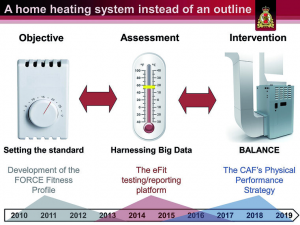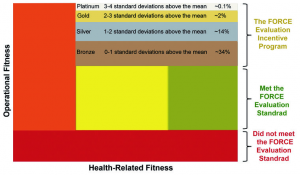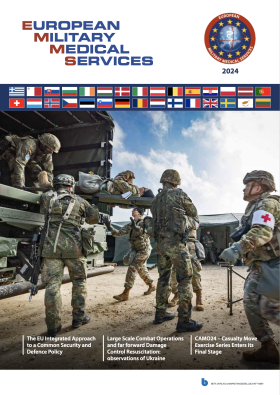
Article: Michael Spivock, PatrickGagnona, Tara Reilly, Phillip Newton, Barry Stockbrugger, Rachel Blacklock, Denis Couturier, Daryl Allard
Health and Fitness Promotion in a Military Setting: The Canadian Perspective
Background
 Fig. 1: The process of ensuring optimal health and physical fitness in CAF personnel
Fig. 1: The process of ensuring optimal health and physical fitness in CAF personnel
The cornerstone of any military is the ability to be ready to respond to a wide variety of challenges at a moment’s notice. Personnel readiness is a function of many factors, the most basic of which is a high degree of physical and mental fitness [5]. For this reason it is essential to ensure optimal health and fitness in military personnel. In Canada, in 1918 our Chief of the Defense Staff has taken the concept of operational readiness one step further, declaring that “In addition to the CAF’s legal obligation to ensure the operational fitness of our personnel, we as leaders have a moral duty to support their general health and wellbeing throughout their careers” [1]
Conceptually, the process of ensuring optimal health and physical fitness in CAF personnel has been likened to a home heating system, where first the objective must be set (setting the desired temperature on the thermostat), then there must be a way to compare current status to that objective (checking the thermometer) and finally, action must be taken to close the gap between desired and current state (the furnace kicking in).
Determining fitness and health requirements:
Setting the thermostat
The process by which a Physical Employment Standard (PES) is developed or re-validated is an exhaustive and resource intensive one [6].
 Fig. 2: The Process of Developing a Physical Employment Standard
Fig. 2: The Process of Developing a Physical Employment Standard
This 12-step process (Figure 2) can be summarized in three main phases: (i) determining the essential and physical demanding tasks required in the occupation, (ii) quantifying the physical demands of those tasks, and (iii) developing a test battery to reflect those demands [3].
It is important to acknowledge that what results from this process is not necessarily a “fitness test”, as it is designed to assess very specific job requirements (ex. weights that must be manipulated) and will likely not cover all dimensions of health-related fitness. For this reason, the Canadian Armed Forces have broadened the scope of the annual PES to the Fitness Profile, which also includes measures of health-related fitness [2]. Though the results of this additional health-related fitness dimension do not carry career implications, they provide information for the individual, as well as guiding programming at an organizational level.
Assessing the current fitness/health status:
Checking the temperature
 Fig. 3: The CAF Fitness Profile
Fig. 3: The CAF Fitness Profile
Given the complexities of integrating health-related and occupational fitness in a single assessment, an electronic data capture and reporting system was developed, whereby personnel are scheduled and tested via an electronic platform. Results are immediately available to the individual for debrief, are automatically transferred to the human resources file, and aggregate data is also available to Commanders via a secure portal. Figure 2 represents a sample of Fitness Profile results, showing operational fitness on the y-axis, and health related fitness on the x-axis. In terms of operational fitness, individuals can find themselves in the red (did not meet the PES), Green/yellow (met the PES) or in the bronze/silver/gold/platinum (for those who attain the incentive levels). In terms of health-related fitness, the yellow and orange categories represent higher risk for all-cause mortality based on body composition and cardiorespiratory fitness. This system can plot individuals, units, or even the overall CAF.
A strategy to promote fitness and health:
Turning on the furnace
Based on extensive baseline data, including Fitness Profile results as a primary outcome measure, the Chief of the Defence Staff of the Canadian Armed Forces recently launched BALANCE – The Canadian Armed Forces Physical Performance Strategy [1].
Based on McLeroy’s Social Ecological Model of Health [4], this strategy strives to create the optimal conditions to support the P4 Behaviours, shown to be strong determinants of physical performance:
- Physical Activity
- Performance Nutrition
- Preventing Injury
- Proper Sleep
Local base-level steering committees (chaired by the base commander) have been provided with baseline data as well as a library of potential evidence-based interventions from which to select. These interventions include simple elements such as walking maps at the exits of buildings to encourage physical activity, as well as more complex activities such as examples of optimal shift schedules to promote adequate sleep.
Conclusions
Promoting health and fitness in a military setting requires scientifically grounded objectives, clear and user-friendly data capture/reporting systems, and a concerted effort of behalf of stakeholders at all levels to create the optimal conditions for a healthy and fit lifestyle.
References
- Department of National Defence: BALANCE: The Canadian Armed Forces Physical Performance Strategy. Ottawa, Canada: Canadian Forces Morale and Welfare Services 2018; , last access 6 June 2020.
- Gagnon P, Spivock M, Reilly TJ, Mattie P, Stockbrugger B: The FORCE fitness profile—adding a measure of health-related fitness to the Canadian Armed Forces operational fitness evaluation. J Strength Cond Res 2015; 29(11S): S192 – S198.
- Gledhill N, Bonneau J: Establishing a Bona Fide Occupational Requirement for Physically Demanding Occupations. In Gledhill N, Bonneau J, Salmon A (eds): Proceeding of the National Forum on Bona Fide Occupational Requirements (pp. 9-13). Toronto, ON: York University 2011.
- McLeroy K R, Bibeau D, Steckler A, Glanz K: An ecological perspective on health promotion programs. Health Educ Q 1988; 15(4): 351–377. read more
- Negm K: Women in Military Uniforms: Looking Beyond the Numbers. Canadian Military Journal 2016; 16(2): 15-26. read more
- Spivock M, Reilly T, Newton P, Blacklock R, Jaenen S: Project FORCE Phase I Report: Identification of common, essential, physically demanding tasks in the CF. Department of National Defence, Assistant Deputy Minister (Science and Technology) 2011; , last access 5 June 2020. read more
Authors
Michael Spivock
Canadian Armed Forces. Directorate of Fitness, Sports and Health Promotion
University of Ottawa. Faculty of Health Sciences. School of Human Kinetics
PatrickGagnon
Canadian Armed Forces. Directorate of Fitness, Sports and Health Promotion
Tara Reilly
Canadian Armed Forces. Directorate of Fitness, Sports and Health Promotion
University of Ottawa. Faculty of Health Sciences. School of Human Kinetics
Phillip Newton
Canadian Armed Forces. Directorate of Fitness, Sports and Health Promotion
Barry Stockbrugger
Canadian Armed Forces. Directorate of Fitness, Sports and Health Promotion
Rachel Blacklock
Canadian Armed Forces. Directorate of Fitness, Sports and Health Promotion
Denis Couturier
Canadian Armed Forces. Directorate of Fitness, Sports and Health Promotion
Daryl Allard
Canadian Armed Forces. Directorate of Fitness, Sports and Health Promotion
Date: 08/25/2020
Source: Wehrmedizinische Monatsschrift 08/2020









